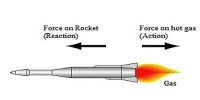Whenever a body in contact with a second one, moves or tends to move, forces opposing the motion come into play. They are tangential to the surface along which motion occurs or tends to occur. These forces are called forces or friction or frictional forces between the two surfaces in contact.
All forms of friction may be classified into following three categories:
(i) Sliding: If the surface of one body slides or tends to slide over that of another, forces of friction opposing such motion are known as sliding forces.
(ii) Rolling: Frictional forces opposing the motion of a body rolling or tending to roll on another are called rolling friction.
(iii) Fluid: When a gas or a liquid (i.e. a fluid) flows across a stationary object moves through a previously stationary fluid, the friction produced is called fluid friction.
The first two categories may be of two kinds:
(1) Static: When there is a tendency of motion between two surfaces in contact, but actually no relative motion, the existing frictional force is called static friction.
(2) Kinetic: When the surface of a body in contact with another is in relative motion, the frictional force that exists is known as kinetic or dynamical friction. It is less than static.
Limiting: The maximum value of the force of static friction when the body is just on the point of sliding is called limiting friction.













